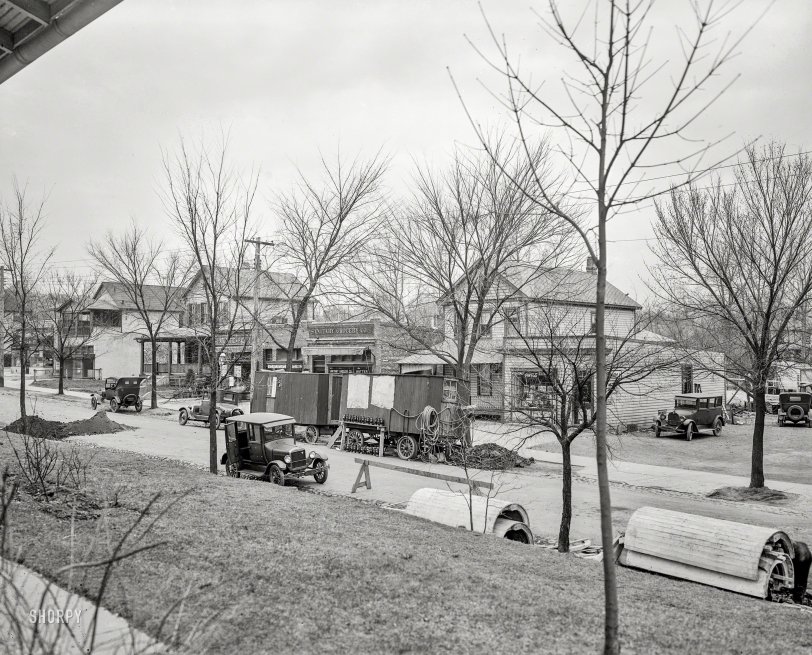


Framed or unframed, desk size to sofa size, printed by us in Arizona and Alabama since 2007. Explore now.
Shorpy is funded by you. Patreon contributors get an ad-free experience.
Learn more.

- Freeze Frame
- Texas Flyer wanted
- Just a Year Too Soon
- WWII -- Replacing men with women at the railroad crossing.
- Yes, Icing
- You kids drive me nuts!
- NOT An Easy Job
- I wonder
- Just add window boxes
- Icing Platform?
- Indiana Harbor Belt abides
- Freezing haze
- Corrections (for those who care)
- C&NW at Nelson
- Fallen Flags
- A dangerous job made worse
- Water Stop
- Passenger trains have right of way over freights?
- Coal
- Never ceases to amaze me.
- Still chuggin' (in model form)
- Great shot
- Westerly Breeze
- For the men, a trapeze
- Tickled
- Sense of loneliness ...
- 2 cents
- Charm City
- What an Outrage
- Brighton Park
Print Emporium
Dig We Must: 1926

Somewhere in Washington, D.C., circa 1926. "S.W. Barrow" is all it says here. Who can pinpoint the location? 8x10 glass negative, National Photo Co. View full size.
Monroe & 18th. NE
The corner of 18th & Monroe at the time this photo was taken in 1928 was the site of a gas station (see the NoNox sign) which employed my father in the late 30's when it was Hite's Shell operated by Romuald T. Hite. In the 60's Mr. Hite retired and sold the business to James A. Fitzpatrick. Both my brother and I worked for Fitz in the late 60's. Of note, in addition to the food chain stores in view, there was a District Grocery Store on the NW corner of the intersection. In the 50's and 60's it was a vibrant little business area.
Collapsible Forms are quick
Collapsible forms are a quick way to create tunnels or sewer piping. Dig a trench of the desired depth and proper width. Pour a concrete footing before or after, plop the forms in place and snug them end to end. Pour concrete, wait. Collapse the forms, and pour the floor. You now have a sewer or raceway to run water, gas, electric, telephone or even liquid fuel lines. I think the floors would be poured after as the arc of the form collapsing would need more height to have clearance. Either that or the floor would be cast with 'curbs' to set the forms on and have clearance to collapse them at the bottom.
In Chicago there was a complete delivery 'small gauge railroad' underground allowing business to be supplied without surface traffic interference. The archways appeared similar.
Tunnel things
The wooden forms look to be centering for the arch of a brick culvert or sewer tunnel. They seem to be hinged in the centre, to allow them to be removed after the arch is built over them. But no sign that anything so extensive is being built.
So what are the 'tunnel' things for?
Could almost see them used for sub-surface work when road needs to be kept open, but their shape would require tons of extra work.
S. W. Barrow
According to the volume "The Gas Age" from 1920, which I found on Google, S.W. Barrow was a contractor in D.C., installing gas lines, water heaters and the like. I take it that the photo depicts one of his projects.
Location Solved
The location is 18th Street N.E., just south of Monroe Street N.E.
An interesting puzzle, as I have no idea what "S.W. Barrow" refers to. I searched the LOC site for S.W. Barrow, and found one other image. In that image, a street lamp with "18th ST N.E." is visible under high magnification, as well as a brick corner building with "3500". With that information, I was able to find the still-extant corner building at 3500 18th St N.E. Amazingly, the old A&P building(s) are still there, although the "Piggly Wiggly" down the street is long gone.
























On Shorpy:
Today’s Top 5